
Current research projects Dr. Martin Pfeiffer
Community ecology
1. Exploring soil food webs in tropical forests of Sarawak
Little is known about the food webs of tropical soils and the role of the different taxonomical groups within them. Ants play an important role in these interactions, not only because of their high abundance and steady presence within all layers of tropical habitats, but also because of their different herbivore, carnivore and detrivore food spectra. The large radiation of certain ant genera and the high diversity of the epigeic and hypogeic ant communities are recognized, however, the reasons for these diversifications are still unknown. In our proposed project in Sarawak/ Malaysia we investigate status and function of ants within the soil food web of the tropical rain forest by analysing stable isotopes (δ 13C und δ 15N) ratios in the macro and meso fauna of the soil. We expect that the results of this study, in combination with the experimental analysis of ant behaviour and ant niche parameters (temperature and humidity needs of the different ant species) can serve as a basis for establishing a model of the niche patterns of ant species that co-occur within rainforest habitats.
In close cooperation with Mrs. Lucy Chong, Sarawak Forestry Corporations, we compare four forest types in Gunung Mulu National Park, Sarawak, Malaysia: mixed dipterocarp forest, alluvial forest, lime stone forest and kerangas. All forests differ in soils, forest structure, biomass, nutritional values, leaf litter mass and leaf litter decomposition rates. Ants are collected with different methods, including Winkler sampling (see fig. 1) This study includes the PhD thesis of Dirk Mezger.
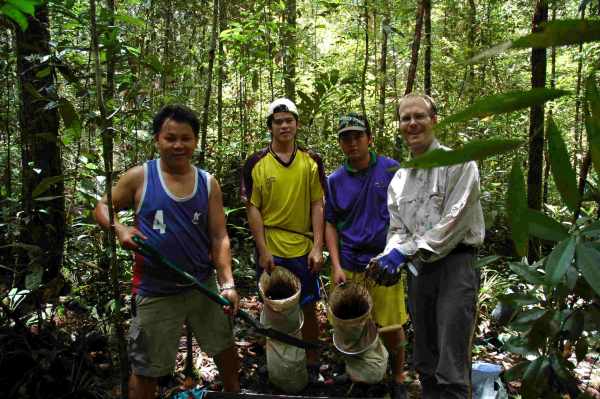 |
Fig 1. Sampling ants from the leaf litter is team work under hard conditions. |
2. Ant communities (Formicidae) in oil palm (Elaeis guineensis) plantations – a biodiversity assessment
Borneo is a major hot spot of arthropod biodiversity, however, over the last 30 years the conversion of primary forest into agricultural land has expanded rapidly. In 2000 about 1 Mio ha or ca. 15% of the total land area of Sabah were covered by plantations of the oil palm Elaeis guineensis , a native wetland species from West Africa. The high productivity of the monocultures is maintained by the use of fertilizer, herbicides and insecticides. Integrated pest management can massively reduce the necessity for insecticide application in oil palm plantations, while disposal of organic matter may help to rebuild the soil structure. Our ongoing project aims at monitoring the effects of these treatments and targets at an improvement of the ecological control of pest insects. We investigate the impact of oil palm cultivation on the natural ant fauna in Malaysia and study the arboreal ant mosaics in oil palm plantations in Peninsular Malaysia and Sabah, Borneo (Fig. 2). This study is conducted in close cooperation with Dr. Ho Cheng Tuck from the Golden Hope Research Centre, and Teh Chong Lay from the Palm Oil Research Station of the Golden Hope Plantations Berhad.
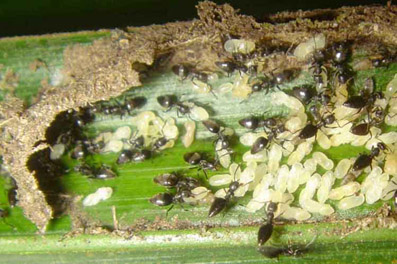 |
Fig 2. Polydomous, arboreal nests are one of the mechanisms that allow species dominance on oil palms: here a nest of tiny Technomyrmex albipes |
Ant distribution patterns and ant macroecology
In these studies we want to get more information about the biogeography, distribution patters and diversity of ants in arid ecosystems along ecological gradients (including temperature, rainfall and altitude).1. Community structure and species richness of ants along an ecological gradient from the Hyrcanian to the Khalijo-Ommanian biome in Iran
Identification of the ant fauna of Iran and the determination of species richness and composition of ants in three main biomes of Iran, Hyrcanian forests, Irano-Touranian semi deserts and deserts and Khalijo-Ommanian, are the most important aims of this project that will be conducted along an ecological gradient, over a transect of about 2000 km from north to south of Iran. This study is the PhD Research of Omid Paknia.
| Fig 3. A desert site near Sepidan, Fars Province, Iran. (Photo: O. Paknia). |
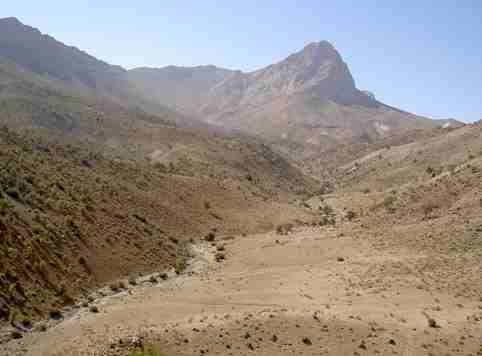 |
2. Ants along a transect from the Mongolian steppe to the Gobi desert
In the South of Mongolia a transition zone extends between Siberian steppe and Gobi desert. A gradient of temperature and moisture combined with different soil conditions results in a mosaic of different vegetation types (e.g., Fig. 3). Ants (Fig. 4) and darkling beetles (Tenebrionidae) that compete especially for food are the dominant groups of the insect fauna in these habitats. Species compositions of both groups were studied in close cooperation with the Department for Ecology of the Mongolian National University in Ulaanbaatar in the year 1997, 1999 and 2003. Further studies are planned. For more information check: Pfeiffer et al. 2003, Pfeiffer et al. (in press) 2007.
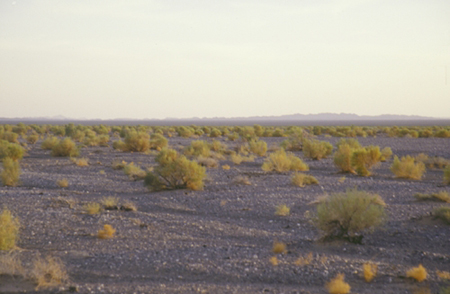 |
|
| Fig. 4: The most southern point of our transect through the Gobi desert, with Haloxylon ammodendron and Reaumuria soongorica as the only vegetation. Here the ant fauna is dominated by Cataglyphis aenescens. | Fig. 5: Mongolian Messor aciculatus ants carrying seeds to their nest. |
3. The Global Ant Database
Rob Dunn, J. P. Lessard, Matt Fitzpatrick, Nate Sanders and Ed Laurent of the North American Ant Database are coordinating the efforts to compile data of the global diversity patterns of ants. Currently a collaboration with more than twenty researchers from 6 continents and roughly a 13 countries (collaborators) is working together to set up the Global Ant Database that will include data from perhaps as many as 1000 sites. I contributed data from Malaysia and Mongolian sites to this study.
Taxonomy and Biodiversity information
www.antbase.net - a myrmecological networking platform
Myrmecologists working in South East Asia now have a tool to verify their ant identifications and communicate ant observations. On www.antbase.net a website, founded by the German Research Foundation (DFG), is dealing with taxonomy and ecology of ants. In close cooperation with ANeT, the international network on ant research in Asia, with Systax, the German provider for GBIF, and together with the Hymenoptera name server of www.antbase.org, the myrmecological site of the American Museum of Natural History, we currently present more than 320 species of 58 ant genera in high resolution pictures. The basis of these large picture base is the extensive ant collection of the University of Würzburg (Chair of K.E. Linsenmair) based on the work of Drs. Carsten Brühl, Andreas Floren, Annette Malsch, Stefanie Berghoff and other researchers. Additionally pictures of many German ant species are presented in cooperation with Dr. Bernhard Seifert of the Natural History Museum in Görlitz. Together with Christiana Klingenberg and Manfred Verhaag of the FoCol-Project (Naturkundemuseum Karlsruhe) we will provide access to automontage pictures of all ant types that are housed in German museums. You'll find much more than 4000 pictures of all subfamilies of ants. All myrmecologists are invited to contribute to this site which focus on ant species of Asia and the Pacific. Currently most pictures are from Malaysia and Mongolia. New cooperations are planned with scientists of Australia, Germany, Iran, Japan, Malaysia and Mongolia that all will add information to antbase.net within next time. So antbase.net will continue to be an exiting tool for a growing group of researchers. The site is run by project manager Hans Peter Katzmann.
| Fig 6. www.antbase.net is a new website and an interesting tool for the myrmecologist. | 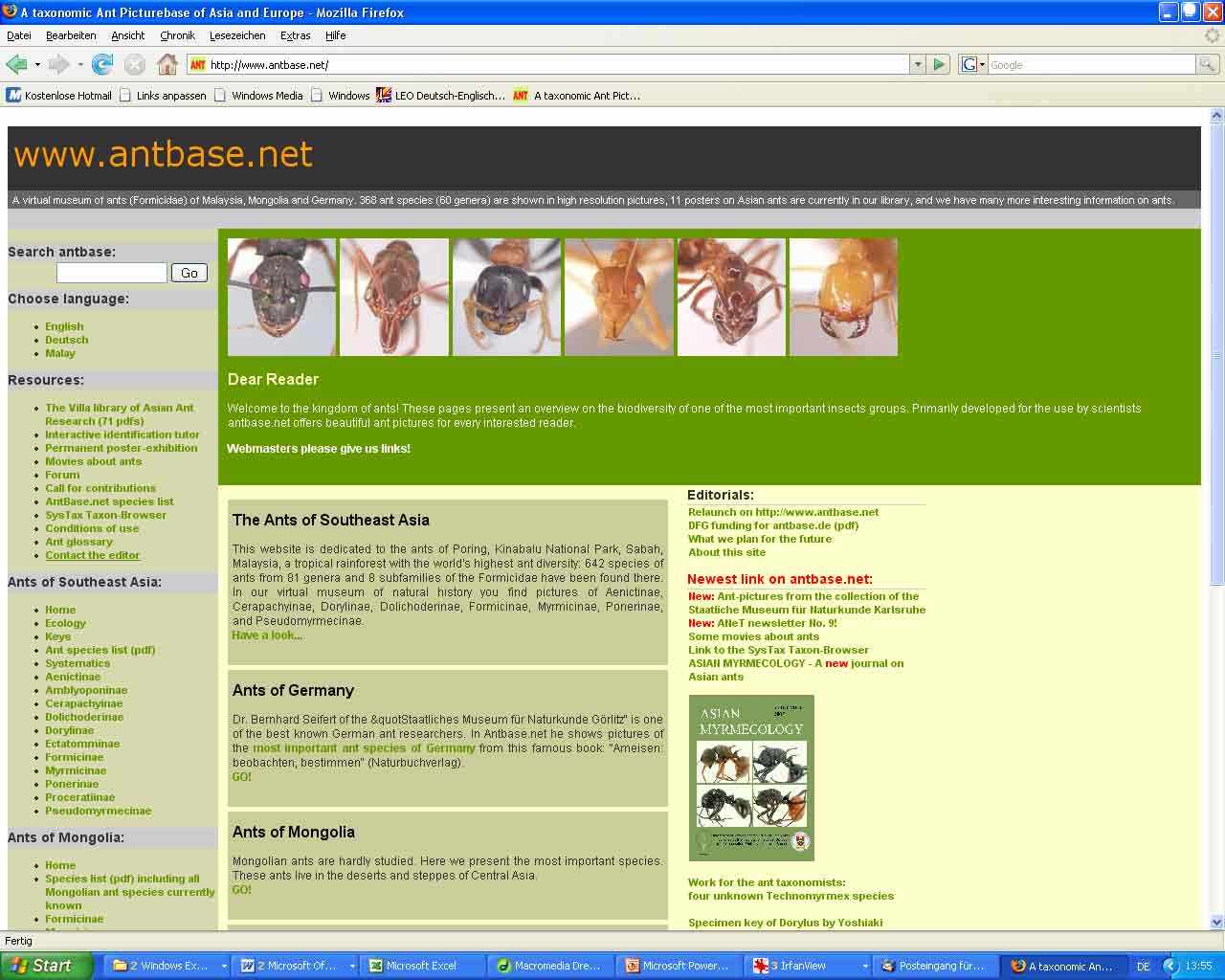 |
Seed dispersal and seed predation by ants – a comparison of ecosystems
In many habitats of the world ants are important seed predators that influence the vegetation layer and therefore the composition and functioning of these ecosystems. On the other hand, many spermatophytes have developed mechanisms that use ants as dispersal vectors for their seeds that bear an "elaiosome" - a nutritive appendage as an ant reward (myrmecochory). So ant-seed interactions range from antagonistic to mutualistic relationships.1. Myrmecochory of spring ephemerals in deciduous forests
We study the mechanisms and the chemistry of the seed dispersal syndrome of different spring ephemerals (Fig. 7) by Formica polyctena ants.
| Fig. 7: A temperate forest during springtime with flowering Anemone nemorosa. Most European spring ephemerals are dispersed by ants. |
2.Seed dispersal and seed predation by ants in three rain forest habitats of Borneo
In the tropical rain forest interactions between ants and seeds are especially manifold. In three protected areas (Kinabalu National Park, Danum Valley, Tawau Hills Park) we are studying diversity and guild structure of harvester ants in cooperation with Sabah Parks and with the Chair of Animal Ecology and Tropical Biology at the University of Würzburg. Besides we are working at a comparative study about the myrmecochory of several ginger species (Zingiberaceae) (see Fig. 8). For more information check: Pfeiffer et al. 2004 and Pfeiffer et al. 2006.
| Fig. 8: In the rainforest of Borneo even arboreal ants like these Oecophylla smaragdina workers carry seeds of the ground vegetation to their nests thus harvesting the seed appendage (elaiosome) that is especially rich in lipids, proteins, and sugars. |
Social Structure and behavioral ecology of giant ants, Camponotus gigas
Camponotus gigas Latreille 1802 occurs in tropical lowland forests of South-East Asia and is one of the largest ants in the world. Giant ants are mostly night active and live in polydomous colonies in territories of about 0.7 ha (Pfeiffer and Linsenmair, 2000). Camponotus gigas is a central place forager combining efficient communication, ergonomic optimization, polyethism and effective recruitment systems (Fig. 9) (Pfeiffer and Linsenmair, 1998). As a tropical species Camponotus gigas shows an aseasonal reproductive pattern: its nuptial flights, which are not fully synchronized within the whole population, occur in a circa-semiannual rhythm with a period of 188 ± 5 days (Pfeiffer and Linsenmair, 1997). Fighting of different colonies happens in highly ritualized combats (Pfeiffer and Linsenmair, 2001). Ants use honeydew from a trophobiotic interaction with the flatids Bythopsyrna circulata (Auchenorrhyncha: Flatidae) (Pfeiffer & Linsenmair 2007 submitted).| Fig. 9: Two major workers of Camponotus gigas in trophallaxis. In C. gigas the exchange of food between workers happens frequently during food transport to and between ants' nests. This mechanism allows perfect adaptation of load weight to worker weight and thus foraging according to the central place foraging strategy. |
Diversity, dynamics and space use of the small mammal community in the rain forest of Borneo
(Ph.D. -project of Konstans Wells)The primary forest on Borneo harbours a diverse and abundant non-volant small mammal fauna, which is dominated by several species of sympatric rats, squirrels and tree shrews, some of which use both the ground and the canopy for foraging. Even though these two habitats are linked by the local productivity and availability of primary resources such as fruits, a different level of complexity and heterogeneity can be assumed. In our study we compare the diversity, dynamics, and space use by the small mammal community within both habitats. For more information see papers of Konstans Wells.
| Fig 10. Maxomis surifer, the red spiny rat a common inhabitant of the rain forests in Borneo. Up to now, only little is known about the mechanisms that structure small mammal communities in this habitat (Photo K. Wells). |




